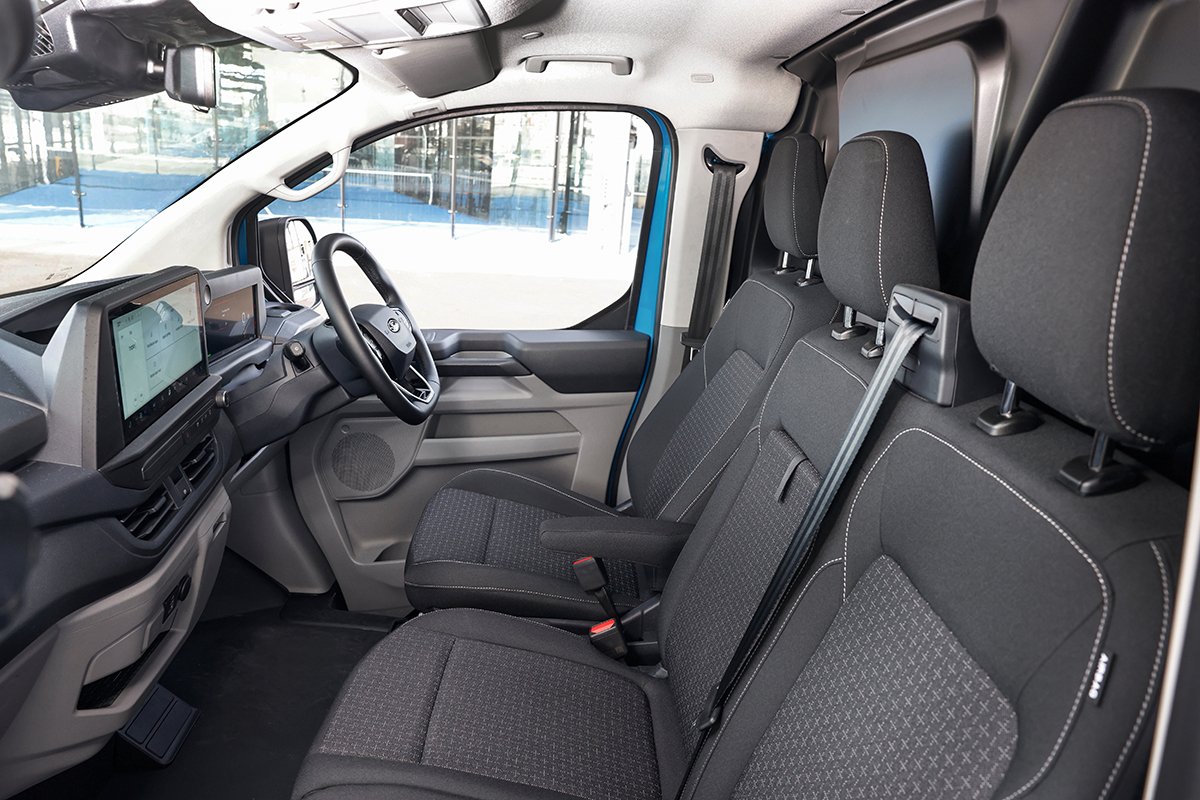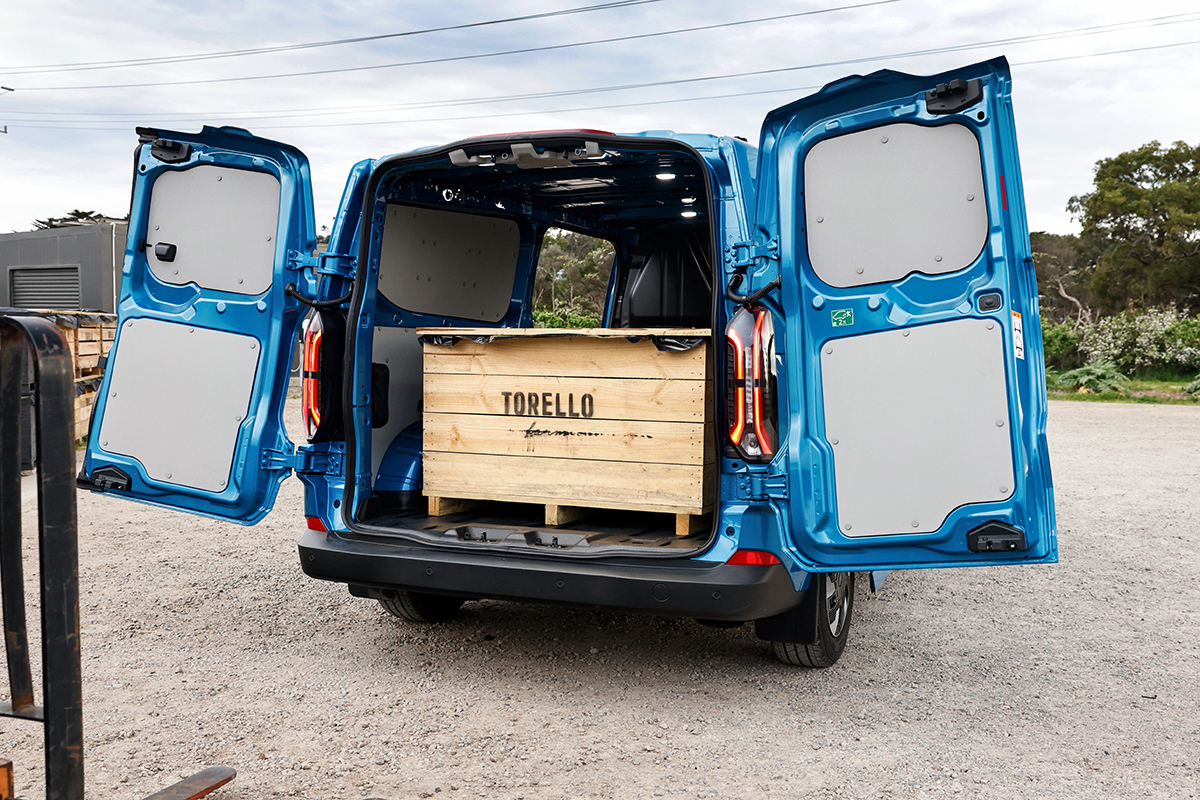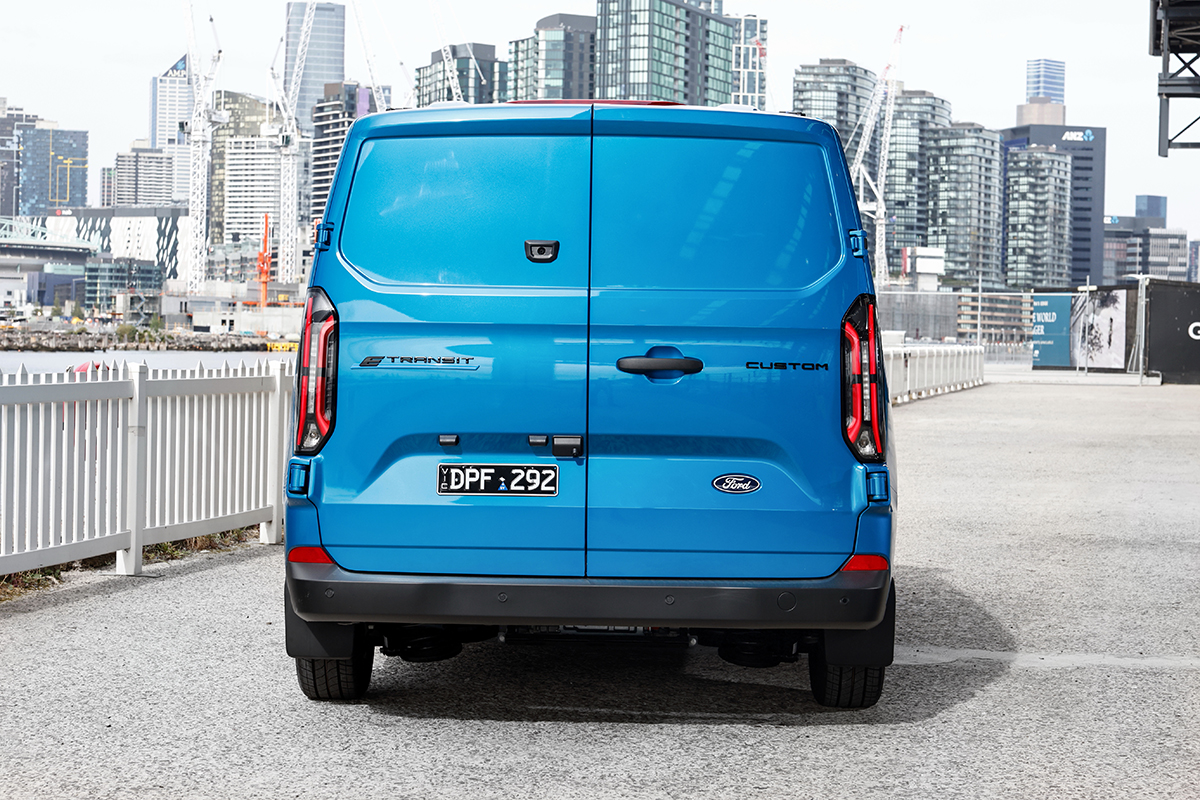
— Liam Murphy
Utilitarianism and commercial vehicles go hand-in hand, with many Australian businesses putting their faith into them to perform whenever and however needed. Because of this, a no-frills approach is often taken to van purchases, resulting in ‘new’ tech, such as electric propulsion, generally being given the flick in favour of tried and tested diesel.
However, arriving this month is the 2026 Ford E-Transit Custom all-electric van, which the brand hopes is going to make people reconsider what an electric commercial (and lifestyle) vehicle can be. We got behind the wheel to see if a battery and electric motor improves on or hinders the van formula.
The 2026 Ford E-Transit Custom is available in two trims, each dedicated to either a short wheelbase (SWB) or long wheelbase (LWB), assuming flagship for the Transit Custom range.
LWB-only Trend kicks off at $77,590 before on-roads, while the SWB-only Sport starts at $79,990.
These prices represent hikes of $10,000 over new plug-in hybrid Transit Custom variants following the same trim and wheelbase designations, and more than $20,000 over cost of entry to a diesel-propelled Trend SWB.
While assuming only a small share of the mid-size van market, comparable electric rivals include the LDV eDeliver 7 (starting at $63,990 drive-away for ABN holders), Peugeot E-Expert (from $79,990 before on-roads), and the Volkswagen ID. Cargo (from $79,990 before on-roads).
For comparison’s sake, buyers can get in a segment-leading Toyota HiAce for just under $55,000, however this is powered purely by diesel and no electric option is available.
Ford Australia guarantees the E-Transit for five years and unlimited kilometres, with its high-voltage battery warrantied for eight years/160,000km. Optional extras include premium paint for $700, a rear liftgate door (to replace standard dual barndoors) for $700, dual side-load doors for $1000 and a single passenger seat (to replace a bench seat) for $150.
Servicing is conducted every 12 months or 30,000km, and totals just $1200 over five years/150,000km. Of Ford Australia’s 178 dealers, 152 of them specialise in EVs, meaning E-Transit Custom owners shouldn’t have to travel too far – or be off the road for too long – to keep them running.
Space is the most valuable commodity inside a commercial van, and Ford has taken measures to gain it wherever possible in the 2026 E-Transit Custom.
Starting things off, most impressively, is placement of the battery pack. E-Transit Custom (and the new plug-in hybrid Transit Custom for that matter) lose zero – that’s right, zero – interior space compared to their pure-combustion counterpart.
In SWB body, this translates to 2602mm of cargo length and 5.2m3 of capacity with the E-Transit’s standard-fit metal bulkhead. Moving to LWB brings these figures up to 3002mm and 6.0m3. Distance between rear wheel arches is even at 1392mm, with SWB height at 1427mm and LWB at 1425mm.
Not keen to whip out the calculator? The above equates to the equivalent of three Euro pallets of space in SWB and four in LWB. Gross vehicle mass sits at 5350kg for both wheelbase options, placing max payload at between 1080-1111kg for SWB and 1156-1187kg for LWB.
Moving ahead of that windowless bulkhead (which makes a rear-view monitor necessary instead of a conventional mirror), a column-mounted shifter, electric parking brake and front airbags tucked up into the roof complement an array of storage pouches in the cabin and flip-up front seats (with stowage underneath) all designed to increase space within the cabin.
An optional Mobile Office Package adds additional, modular mounting points for phones and other devices, and a tilt function to the steering wheel which allows it to double as an angled laptop platform or flat desk.
Despite van proportions, driving position and overall ergonomics are well sorted, not creating the sense you’re sat atop a milk crate while driving. Seats are clearly designed for quick ingress and egress, however what bolster and lumbar has been applied works to good effect, keeping drivers and passengers planted without a lot of head wobble over bumps.
A 12-inch digital driver display adds a lick more modernity to the cabin, befitting given its electric powertrain, while a 13-inch centre touchscreen runs the brand’s SYNC4 interface, with integrated navigation and a 5G model built in.
Apple CarPlay and Android Auto can also be projected wirelessly and, overall, the system is good, providing response and clarity. Though, as has irked us in other Ford models before, a few too many controls (such as air conditioning) are housed within the infotainment for our liking.
Straddling the line between commercial and lifestyle, the 2026 Ford E-Transit Custom comes with a decent list of inclusions making it relevant for both.
In addition to screens and connectivity mentioned above, the E-Transit also scores a keyless push button start, with Sport variants picking up keyless entry. Manual eight-way adjustment comes fitted on Trend for drivers, with Sport gaining 10-way electric adjustment.
Standard for E-Transit, a Secure Visibility Pack adds that previously mentioned metal bulkhead, a digital rear view monitor with integrated dashcam, and rear doors that do away with windows.
Being commercial vehicle exceeding 3.5 tonnes, the 2026 Ford E-Transit Custom undergoes different ANCAP scoring than its traditional out-of-five rating.
Scoring 96 per cent overall, and a top platinum score, the E-Transit Custom is about as safe as vans get.
Unsurprising, when it has a safety suite including adaptive cruise with stop-go, traffic sign recognition and lane-centering, blind spit monitor and assist, rear cross-traffic alert, emergency call assist, exit and forward collision warnings, lane-keep assist and departure warning, front and rear parking sensors, autonomous emergency braking, a rear-view camera (with 180-degree field of view), reverse brake assist, side wind stabilisation, traffic sign recognition, trailer sway control and a tyre pressure monitoring system.
A 64kWh lithium-ion battery pack sits below the floor of the new E-Transit custom, sending power to a single electric motor driving the rear wheels.
Figures are rated at 160kW and 415Nm, with a claimed driving range of 307km for SWB and 301km for LWB. Braked towing is rated at an impressive 2300kg.
Ford Australia is confident that the E-Transit Custom’s lithium-ion battery is adequate for commercial usage, based on what it says is data collected from 4640 of its commercial vehicles covering 12.49 million trips, finding that the average daily distance travelled is 78km.
Charging rates are healthy, especially considering much of this will like be done on back-to-base fleet vehicles. DC can be done at 125kW, while AC is rated to 11kW.
A vapour-injected heat pump further increases efficiency of the battery by ensuring it stays within its optimal operating temperature window.




The E-Transit Custom makes for a fine drive out on the road in most conditions, though our testing of a completely unladen example probably did not play to some of its strengths.
One of these is ride harshness, which is excessive when both wheels of an axle are asked to work together at the same time, such as over a speedbump. A heavy load on board would force more compliance into suspension, but even compared to other models in its category, stiffness when unladen is high.
Despite this, the E-Transit Custom sits flat when on the move, not feeling overly susceptible to changes in road camber and imperfections, or side winds. Road suppression is impressive considering much of the body has no insulation and there is no chattering diesel competing for your ear drums.
Our time behind the wheel was not long, but we stepped out with a strong impression you could rack up hours behind the wheel each day without unnecessary fatigue.
Steering is direct and brake pedal operation is consistent and confidence-inspiring, with regeneration for the battery incorporated smoothly. This being said, we’d like to see the one-pedal driving mode softened for low-speed manoeuvrability, as it can prove a bit jerky.
Torque delivery, as you’d expect from an electric powertrain, is instant and plentiful. Unladen, the E-Transit Custom is comically fast to accelerate given what it is, and it’s clear it would face little hardship carrying or towing a decent load.
Perhaps most impressively during our test was energy consumption, which averaged out at just 14-15kWh/100km according to the onboard trip computer.
The 2026 Hyundai Palisade is the kind of car we like to think we’d build if given the chance to head a car company.
A clear design brief seems to have been laid out and followed to a T, resulting in a car that knows exactly what it’s trying to be – unapologetically displaying an ‘it costs whatever it needs to cost’ attitude in the process.
A hair under $90k might seem an outlandish price to pay for a hybrid Hyundai, but, if you’ve got the cash and the criteria, it seems hard to imagine where else it could be better spent.